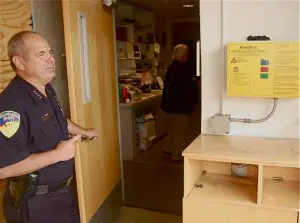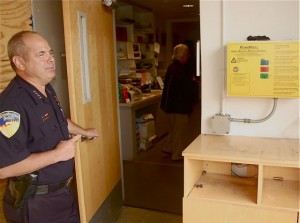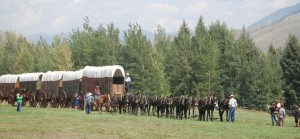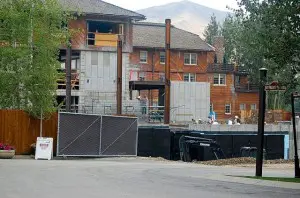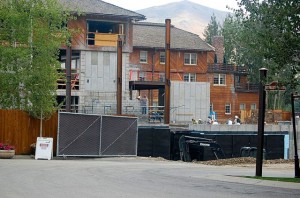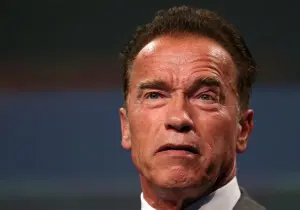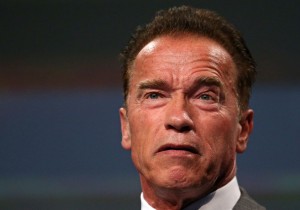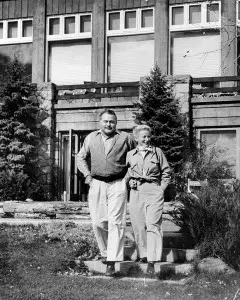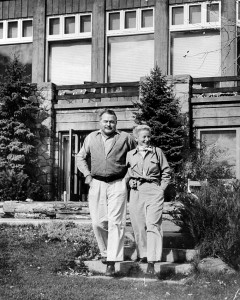The Wisdom 2.0 Bottom Line
March 2, 2015
I spent the last few days at the annual Wisdom 2.0 conference in San Francisco.
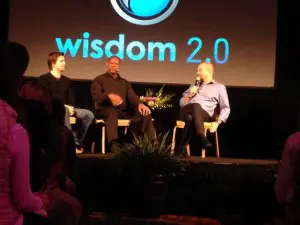
Michael Gervais, (left) George Mumford and Mike Robbins (right) discuss sports and psychology and the Wisdom 2.0 conference in San Francisco February 28, 2015,
Many of you have probably never heard of the event, so a little context is probably in order.
Attendance this year reached 2500 and could have gone higher if organizers had not capped it. The conference is designed as a combination celebration and support group for anyone trying to bring more: (pick one) consciousness, gratitude, or mindfulness to technology and business.
Attendees come from all over the world, although a large percentage are from California, to hear a variety of speakers from CEO’s to human resource managers, explain how they have tried to humanize their companies and deal with the increasing demands of the ‘always on’ world.
Using mindful meditation, exhortations to be present, and a wide variety of what many might consider alternative techniques, the conference is in direct contrast to the prevailing view of corporate America as a ruthless, cut throat, bottom line, profit driven culture.
In addition to the conference presentations on everything from neuroscience to networking, there are rooms devoted to meditation, and yoga, as well as a trade show in the Inspiration Lounge.
Many sessions focus on how to live a more fulfilling and compassionate life and to make choices that leave you happier both personally and in your career.
Here you can also find the latest in relaxation and stress reduction equipment and techniques.
While you might think the principles were some import from Europe, most of the foreign attendees, are quick to note that the techniques are uniquely American, which is what draws them here.
Companies with representative include LinkedIn, Facebook, Twitter, Google, Gap and a host of others who say that recent studies have shown conclusively that promoting mindfulness and self realization in their workforce actually adds to their bottom line in quantifiable manner.
In reality the conference is a large networking event, where like-minded folks can get together to reinforce their beliefs in hopes of connecting with someone who can help them move forward in their career.
A large percentage of the attendees are personal/executive coaches or management consultants, who are looking to make connections with those HR types from Google, Twitter, Facebook and GAP, to improve workplace performance. Admittedly the chances are slim, but you never know.
In two days I collected a raft of business cards, and spoke with lawyers, coaches, HR managers and some old friends from the spa and yoga worlds.
My wife, who is a clinical psychologist, and attended the first Wisdom conference 6 years ago, may be a more typical participant, but she was ill over the weekend and insisted I attend.
I’ll admit I was hesitant, but after three days I was pleasantly surprised and happy I made the effort. More on some of the things I learned will come in subsequent posts.
When organizers at the opening session asked who, in the audience, was a first-time attendee, I raised my hand along with two-thirds of the crowd.
Sponsors were thrilled, saying it showed how the movement was attracting new members. But you have to think; what does it mean when attendees at previous sessions are not coming back in significant numbers?
If this were a business that had to rely on new customers for 66% of it’s profit each year, would you be optimistic?
Kensington in the Spotlight
February 22, 2015
Recently, I’ve had a few calls from friends around the country asking bluntly, “What the heck is going on in Kensington?”
For those of you who missed it, our little town has been the subject of some notoriety since it was revealed that an off-duty police officer ( and three other colleagues) drove to Reno, NV (about 3 hours) for a weekend of fun and promptly lost his gun, badge, handcuffs, and ammunition to a prostitute.
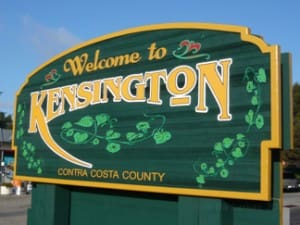
Journalistically, the best part of the story was how the gun was recovered the next day, when the woman’s pimp apparently shot himself during a dispute when he was attempting to pawn the items.
Our local police chief “investigated” the matter for 8 months but only suspended the officer when the story became public. As you might expect, the community was a bit upset at the chief’s delay. Over 250 folks turned out for a police board meeting on the issue.
He’s now our former chief, although the suspended officer is still on the force.
Kensington is a small upper-middle class community in the East Bay hills. Our major claim to fame, until now, was that Daniel Ellsberg lived here. Over 70% of the population have, not only college degrees, but advanced degrees. The community is off the beaten track, and most of us like it that way. There are no major roads that would lead anyone to come here, unless you were on the way to your home, and most of the time when you tell someone you live in Kensington the reaction is “where’s that?”
Plus, we pay a yearly assessment, so that we can have a police department of 10, dedicated to patrolling our streets to protect us from the rest of the world. We also have an excellent elementary school which makes this a great place to raise a family.
The spotlight that has been shining on us over the last few weeks, has been very uncomfortable.
I have no new information to reveal about what will happen next and most of you probably don’t want to know about the politics of a small, wealthy community in the Bay Area, but there are some things to note.
First, the chief and the 5-member police board to which he reports, have screwed up big time. The chief, who also acts as general manager, will no longer be serving us, and for the second time in ten years, we are looking for a new commander.
Second, a large part of the problem is based in the combination role the police chief is asked to fill. Police Chief and General Manager is just an untenable combination, which the board is finally looking into changing.
Third, a small group of dissidents is using the incident to further their own, long-standing goal of ousting the three majority board members. Additionally, they want us to combine our police force with the neighboring town of El Cerrito, which may make sense financially, but not from a public safety perspective.
This story will continue to play out over the next year. Hopefully out of the national or state-wide spotlight. My hunch is we’ll have a recall election, which will fail, and we will separate the two top posts in town, and then there will be a ballot initiative to combine our police force with our neighbor, which will also fail.
The whole battle will be quite acrimonious, and make for lots of local hand wringing, but in the end, everyone will go back to ignoring the our little town and we can all get on with our lives.
Another ‘Berkeley Moment’
February 2, 2015
Berkeley gets a bad rap from those who have never lived here, but there are some vignettes that capture its essence.
Last Saturday night, just after dark, my wife and I were walking down Vine Street after a light dinner.

Vine Street is a main drag in the City’s ‘gourmet ghetto’ – a block from Chez Panisse, and Saul’s Deli – both icons , but on opposite ends of the foodie spectrum.
We’re just strolling along when we see a young man, obviously a Hasidic Jew, standing next to a parking meter. At the same time another man, slightly taller, but with glasses, and also wearing black hat, rekel (black coat) and payot (side curls) walks out a small door. After a quick hello, he asks me, “Are you Jewish?”
I’d never been asked quite that directly, but since it obviously wasn’t meant in any kind of derogatory fashion, I answered, “Why yes, we are. Is it that obvious?”
Without skipping a beat, the man in glasses responds, “Well, yes it is.”
It was clear that he had a sense of humor, so I asked, “Are you Jewish?”
He smiled and answered, “What gave it away, my glasses?”
Turns out he was just looking for congregants to make a minion (10 men) so they could say their prayers to end the Sabbath (Saturday evening).
But, It’s just one of those “only in Berkeley” moments, that makes the city so great.
And no, I did not join the minion, but that’s a more complicated question.
Thank You, US Postal Service
January 25, 2015
The United States Postal Service gets a lot of grief these days. Derided as the delivery agent for ‘snail mail,’ they are criticized for being too expensive, too slow, outdated and time consuming in the era of instant communication.
Yes, I have tracked letters sent via ‘Priority Mail’ as they traveled to San Diego before reaching their intended destination 10 days later, two zip codes from my office. I can send a package to Hawaii (from San Francisco) in two days, but the same size box to Boston takes over a week.
And yes, grandma, I remember when a first class stamp was 5 cents. I now buy forever stamps in rolls of 100, so I don’t even know what first class postage is. (Great marketing, if you ask me.)
I can text my friends all over the country and within 10 minutes will have a response…any longer and I get impatient. Email, which we all thought was great a few years ago, is now too slow, since most people still have to check before responding.
I tweet to my followers, and most of my relatives have Facebook pages,so we’ll all know who’s doing what. I write this blog so everyone knows how I feel about what’s going on in the world.
But none of those methods can generate the emotions of a stamped letter. Neuroscientists now know that memories are more than just events. Our brains recall all five senses and any of them can spark a memory.
I was reminded of that this week, when a good friend, David Allen, sent me a batch of letters, found while cleaning out his mother-in-law’s attic.
They were written over 47 years ago when I was a freshman at Bucknell University in Lewisburg, PA. In fact, they were written in the first few months of college, when I was really still attached to my high school experience and scared to death about the future.
I remember the onion paper, the smell of the inked ribbon , and the old green and white Smith Corona that I used, to peck out letters to my parents, friends and former high school classmates. I still have the typewriter in fact – even had it reconditioned after I found it while going through my old homestead when my Dad died. I’m told it’s a collector’s item.
The letters were written to David’s wife, Betty, my best friend, and while we were never involved romantically, are filled with good natured banter that would pass for flirtation.
The actual content is really irrelevant: my observations about classes, social life, campus events, and gossip. It was 1967, and I know every campus was awash in protest and politics, but there’s none of that, so I doubt Oliver Stone will need them for some new 1960’s expose.
But for me, they are more important than any email, tweet or text I will ever send. When I re-read the words, and hold the letters, the memories of those years come flooding back. More importantly, I’m talking to my friend, Betty, again, even though she was struck down by cancer 12 years ago.
So, while I can find endless versions of various web pages, and can see the trail of my texts to friends and colleagues, none of them will ever hold the power of the printed word that I can pick up, hold in my hand, and still smell the memories from so many years ago.
For that I thank the US Postal Service and David, who was thoughtful enough to mail them back to me..
Would You Reprint Charlie Hebdo’s Cartoons?
January 13, 2015
Ever since the attack on Charlie Hebdo last week I’ve been wondering what I would have done if I were still an editor at a newspaper.
The day after the attack, I was consumed with embarrassment for my profession when so few papers, who reported the murders, printed any of the offending cartoons.

As part of their coverage some publications in Europe did print a cartoon, but except for the Washington Post, I’m not aware of any major US publications who printed an example.
Even the Post printed the cartoon on the editorial page leaving the news columns free to describe the artwork. They, like the New York Times and other publications, claimed the actual drawing ‘were not relevant’ and their message could be communicated in words.
Clearly the cartoons were relevant, and just as clearly, mere words could not describe why the cartoons led to the attack. In truth, after looking at a sampling of the cartoons, I found many childish, insulting and tasteless, but I would still defend their right to publish them.
Almost every religion came under attack, but according to some, only the Muslim faith specifically prohibits depictions of their prophet.
My outrage, was tempered by a good friend, recently ‘retired’ from a small local publication, who noted that if had been editor, he’s not sure if, as a married father, he could take the risk of publication, even in a small hometown weekly.
Would the emotions of any editor be any different. Presumably they could all be the mothers or fathers of young children, and publication would open them up to the same fate as Charlie Hebdo’s cartoonists.
I guess my anger was more rooted in the excuse that the cartoons “were not relevant” to the story. I just wish the editors would admit they were scared and, while they knew that failure to publish meant the jihadists had won, they would be honest about it.
I had the same thought this week when the new cover of Charlie Hebdo was released and the announcement in my email, only showed half the drawing.
I still don’t know what I would have done, were I still the editor of a newspaper or even if I should use a cartoon to illustrate this blog post?
But I hope I would at least be honest with my readers.
Maybe, if somehow everyone published the cartoons, there would be strength in numbers like the 1 million French citizens who marched in defiant solidarity in Paris last weekend.
Salary Talk
October 9, 2014
Should you discuss salary at a job interview?
My answer is an unequivocal, “No,” although I admit sometimes it’s impossible to avoid.
A recent example from my practice explains why. My client recently graduated from college and was about to go out on his second job interview. (His first landed him a job offer that he turned down because of the location – but that’s a different post)
We were going over possible interview questions and he asked about salary. I gave him my standard answer and we talked about ways to deflect questions.
I explained that the purpose of an interview is to get an offer and once you have an offer that’s when you discuss salary and benefits.
“But what if they just ask directly, how much money I want?” he asked. I suggested he explain that he didn’t know the exact job responsibilities, so he could not estimate what the salary should be. The point is ,that if they have not published a salary range, you don’t want to ask for too little or too much. There are a host of negotiating techniques and strategies at play, but that’s it, in a nutshell.
After the interview he called to say, sure enough, they asked for a salary requirement and were insistent that he offer a number. None of my suggested answers put them off, so he gave them a number.
Guess what, three weeks later, he got a job offer and the salary was exactly number he mentioned. He asked if it would be improper to ask for more and I assured him that it certainly was not out of bounds. We discussed how he should approach the matter, given what he said at the interview and he told me later that he got a small boost, but it made him feel much better about taking the job.
If you want another real world example check out this from Maria Klawe President of Harvey Mudd College at a recent forum on women and pay. She admits that she left $50,000/year on the table because she accepted the job and then asked about salary.
My advice, whether you know the salary range in advance, or not, try not to offer an expected salary or you will always wonder if you left money on the table.
Unconscious Bias
September 24, 2014
A lot has been written over the last year about steps Silicon Valley companies are taking to combat bias in hiring.
In case you missed it, over 70% of the workforce at many firms, is white and male. A recent NYT article details the problem and some proposed solutions.
But I think the issue is closer to most people’s homes than they realize. A recent example helps prove my point.
My ophthalmologist, is the mother of twins , a boy and a girl. I have been seeing her for almost 15 years so I’ve followed the normal trials and tribulations of parenting.
The children are now, at 15, starting to make choices about college and careers. At my last appointment the doctor said the young man had really applied himself and was looking forward to technology/science as a career and was looking at top tech schools.
When I asked about her daughter, the doctor said she found math and science “too hard,” adding,”all my friends just want to get Liberal Arts degrees.” The doctor’s response,”Well, OK, if that’s what you want.”
I was slightly appalled, and my expression must have revealed my thoughts, because she asked, “Do you think I should have pushed her more?”
We had a lengthy discussion, in between eye chart readings. But it made me wonder how many other subtle signals the little girl had received about avoiding math and science.
It’s no surprise the Silicon Valley workforce is overwhelmingly male, if even a professional women, in a field that certainly required some science (ophthalmology), wouldn’t even urge her daughter to consider science and math because they are “too hard.”
Maybe a short visit with an unbiased career counselor/coach would help break through the peer pressure and produce a few more female engineers for the next great startup.
On the Road Again
September 3, 2014
My wife and I just got back from a road trip to Sun Valley, ID. For more on that, see my previous post. Among other things, we took in the annual Wagon Days celebration in Ketchum- complete with the jerk line mule team.
This was our first drive through this part of the world and I can’t help making a number of observations.
If ever there was a place where there is no ‘there, there’ this is it. The fact that Burning Man is held 75 miles north tells you how far off the beaten path Black Rock Desert is.
The five hours from Reno to Elko has a number of exits with town names, but you couldn’t see much more than a few trailers by the side of the road.
The exception was Imlay, home of the Thunder Mountain Monument – a unique home constructed of debris from the local junkyard, and concrete.
The major industry in Northern NV appears to be power production and mining. Where else do you see road signs promoting Barrick Gold.
It was still nice to see my tax dollars at work repairing overpasses at 5,000 feet with lanes closed and minor backups. I found some of the downhill sections of the high desert a bit intimidating and I couldn’t figure out why until I noticed there were no guard rails. Nothing to keep sleepy motorists from simply driving off the road and down 1,000 foot embankments. We did see one car which did just that.
Parts of Route 80 in California are similar. I assume it’s to leave room for snow plowing, but still, it is odd.
Speaking of Route 80. Let me suggest that you don’t drive West on Labor Day. You’ll be joined by about 15,000 folks leaving Burning Man, along with the usual Labor Day traffic. Since many of these weekend Burners have never driven a trailer or camper before (much less a motor home) their skill at navigating Donner Pass was negligible. The result was a backup from Truckee to Nevada City, even though there wasn’t a serious accident in sight.
Two other stops to avoid during that period are the truck stop in Fernly, NV which must be the only gas station on the way out of Gerlach, and the new Whole Foods in Reno. Every other car we saw was covered in the signature desert dust of Black Rock and filled with hungry shoppers snapping up food for the trip home to the Bay Area.
If you ever decide to make the 11-hour drive to Sun Valley, let me add one word of caution on road signs. I have a particular pet peeve with signage that isn’t clear to someone who hasn’t driven the road before. A case in point is SR93 in Twin Falls – a lovely new bypass that takes travelers outside of the downtown area, though a number of mall zones, that US suburbs have made famous.
Problem is, unless you spot a single small sign pointing out a left turn, to continue on SR93 you will wind up far from you eventual destination. I guess the folks in Twin Falls just like to have lost motorists driving around aimlessly.
My favorite road sign of the whole trip was just outside of Elko, proudly proclaiming an exit for Beverly Hills. I’m sure Rodeo Drive was just off the exit ramp.
Sun Valley Serenade
September 2, 2014
My wife and I closed another hotel this weekend.
Well, I guess the Sun Valley Lodge was going to shut down for 9-month renovation, whether we stayed or not, but we were among the last guests to see the Lodge in its current incarnation.
The 124-room, 78-year old symbol of high-end fun in the snow will be converted into a 96-room playground for the rich and famous.
The Lodge will renovate every room, except one, expanding them to accommodate fireplaces, and updated bathrooms which will include Jacuzzi tubs and modern amenities.
The truth is the renovation is long overdue. While the Lodge, which bills itself as America’s first destination ski resort, is the priciest in the Ketchum-Sun Valley area, it fares poorly when compared to many budget priced hotel rooms. Where rooms are larger, and bathroom space for two people often included double sinks.
The Lodge was built in 1935 by the Union Pacific Railroad and has only had three owners. It’s only relatively recently that the current owner Carol Holding, who owned Sinclair Oil with her late husband Earl, made the resort and the surrounding area into a year-round destination.
The Holdings also own a number of other five-star resort properties in the Western United States
Before Mr. Holding, began marketing the location to events such as the annual Allen and Co. technology and media conference, most of the private jets at the Blaine County airport, only came during ski season. Now it’s not unusual to see folks like Arnold Schwarzenegger, Mariel Hemmingway, or tech moguls wandering downtown Ketchum year round.
California’s former governor was there over the recent Labor Day weekend, with his current young honey, but that’s a story for another post.
For the last four months the Lodge has been the site of a major addition to accommodate a new spa and fitness center as well as several 4-bedroom apartment units designed for families or wedding parties.
You can find more details about the renovation at the Lodge website but you won’t be able to stay there until June of 2015 – just in time for the Allen and Company gathering.
A true sign of the year-round nature of the Lodge business, is the fact that they are closing for the what used to be high-season for The Valley ski industry.
Until next summer, you can stay at the Sun Valley Inn, the sister hotel barely 100 yards away, or at any of the many condominiums managed by the Lodge.
In general, locals are thrilled and seem genuinely happy that a new generation of the Holding family is taking an active interest in managing the mini-empire. Carol Holding, is in her 80’s, and has been largely a ceremonial leader since her husband died in 2013 but her son, Stephen, has apparently taken over and as the press release says, wants to guarantee another 75 years of ownership.
By the way, that lone room that will not be renovated? You guessed it – room 206, which hosted Ernest Hemingway and his lover in 1939, as ‘Papa’ finished “For Whom the Bell Tolls.” Current hotel employees say the room has never been fully renovated and includes the original claw-foot tub- and can still be rented – although the plumbing apparently clogs frequently.
But the isolated cabin, where Hemingway lived during his Sun Valley years, and where he died, is on private land and not open to the public.
If my wife and I probably win the lottery by next year- we’ll be able to afford the rates at the new Lodge, since the area is truly a beautiful destination any time of the year and we look forward to returning for the annual Sun Valley Wellness Festival next May.
What’s Wrong with Mr. Obama?
July 6, 2014
Recently Peggy Noonan at the WSJ wondered how President Obama could have failed so badly, at least according to a recent poll.
I couldn’t help wondering what was so bad about our foreign and domestic policy.
Exactly what part of our foreign policy is a disaster?

